Post by TasunkaWitko on May 2, 2012 17:12:20 GMT -5
Costillas de Cerdo Parrillas al Yucatán
We've recently been talking a lot about naranja agria, which comes from a specific orange: the Seville orange, also known as the "sour" or "bitter" orange:
foodsoftheworld.activeboards.net/forum_posts.asp?TID=2012&title=seville-naranja-agria-for-latin-cooking
Because of this, I became interested in its use in cooking, the origins of which reach all the way back to medieval Spain and the orange groves of Seville - and from there back to the cradle of civilisation via the Mohammaden conquests. Wikipedia offers some useful information:
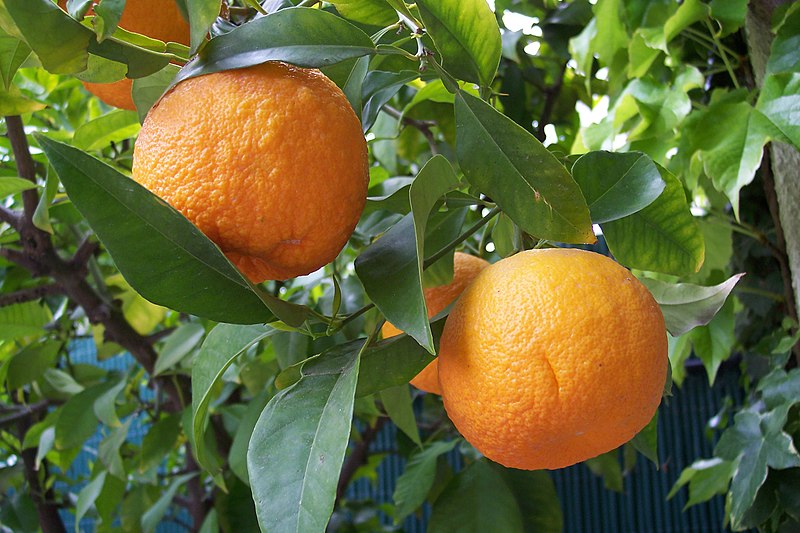
[The]Seville orange is a widely-known, particularly tart orange which is now grown throughout the Mediterranean region. It has a thick, dimpled skin, and is prized for making marmalade, being higher in pectin than the sweet orange, and therefore giving a better set and a higher yield. It is also used in compotes and for orange-flavored liqueurs. Once a year, oranges of this variety are collected from trees in Seville and shipped to Britain to be used in marmalade....
Wiki goes on to enumerate many of the uses for the various varieties of the "bitter orange" (emphasis mine):
My plan was to give this "sour orange" juice a try, using a quintessential Latin-American method: as a marinade for barbecued pork - in this case, spare ribs and baby back ribs.
Of course, the first step was to acquire some naranja agria, which can be quite a challenge in Montana. I was unable to locate any locally, nor could i find it in Montana's two largest "cities," Billings and Great Falls. Further inquiries to "specialty groceries" in the capital city of Helena and the university towns of Bozeman and Missoula yielded no luck. It might be somewhere in this great state, but I wasn't able to find it. One option would be to substitute a mixture of lime, orange and grapefruit juices:
This would be perfectly acceptable, but I decided to make use of the internet and order some from Amazon:
www.amazon.com/Badia-Sour-Orange-Naranja-Agria/dp/B000AQFF8G/ref=sr_1_3?s=grocery&ie=UTF8&qid=1334083758&sr=1-3

The product description states that it is made from Seville oranges, so it is the real deal ~ perfect for what I was looking for. When it arrived last week, I was ready to get this going, so Friday, I bought a rack of baby back ribs and a rack of spare ribs, the latter of which I trimmed St. Louis style:
foodsoftheworld.activeboards.net/forum_posts.asp?TID=1327&title=trimming-spareribs-st-louis-style
I marinated the ribs overnight in a bottle of the naranja agria, to which i added a small amount of salt, cumin, granulated garlic, coriander and annato (about two teaspoons altogether).
Saturday morning, I commenced with this project - the first real barbecue of the year. I began by sprucing up my modified SnP (here's an old thread describing mods in detail and in sequence):
foodsoftheworld.activeboards.net/forum_posts.asp?TID=203&title=modifications-for-the-brinkmann-smoken-pit
The winter and the passage of time had added a little rust here and there, especially over the firebox, but no worries at all ~ when the pit heated up, I gave it a good wire brushing and then a rub-down with some lard, in 3 or 4 layers, which seasoned it beautifully, just like a cast-iron pan. This took care of the rust and brought it back to better-than-new condition.
With the pit ready for its first firing-up of the year, I turned my attention to preparing my ribs. Aside from the overnight bath in the naranja agria marinade, here's a shot of everything I used:
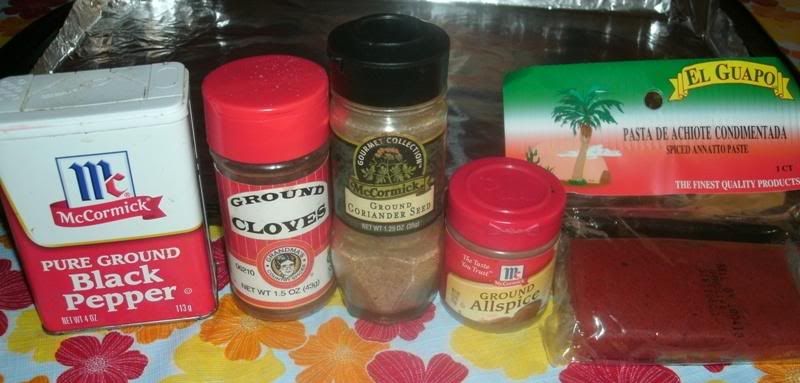
As you can see, we're not looking at anything complicated here, but the resulting flavours are full of depth and character, heightened by the citrus blast from the Seville orange juice.
The medium for this masterpiece from the Yucatán was a paste made from achiote roja, a block of wonderful Latin flavours that can be found just about anywhere except where I live:

I had to go 250 miles to Billings in order to get this stuff; considering the simple-yet-wonderful ingredients, I might experiment in the future with making this on my own from scratch.
One thing I wanted to do was to give a real boost to the flavours found in the achiote, so I added a few spices:
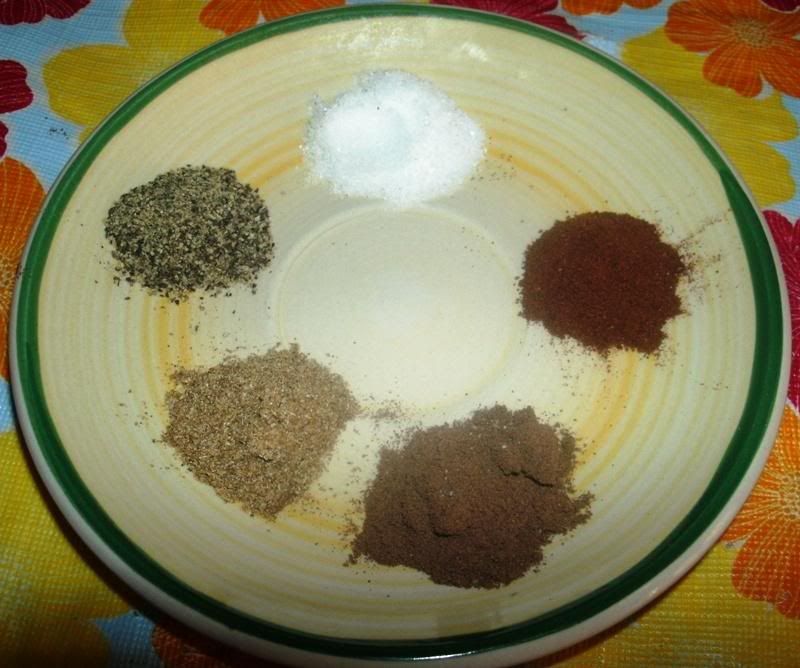
Clockwise from top: a teaspoon each (scant or generous, depending on the ingredient) of salt, ground cloves, allspice, coriander and pepper; I would also have added the same amount of granulated garlic, but for some reason, none could be found in the house.
After measuring out the spices, I opened the block of achiote roja and added 2 tablespoons of the reserved naranja agria marinade:
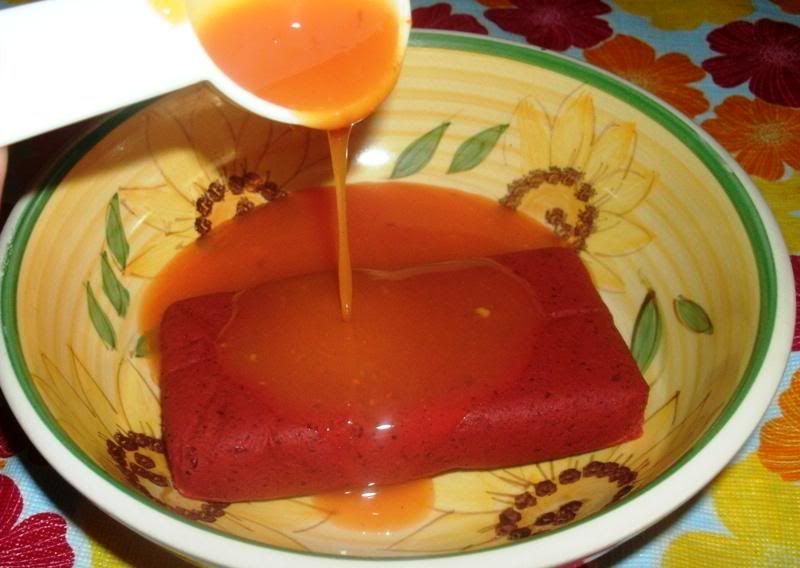
I then added the spices and i stirred it all together to make a beautiful-looking, deep-crimson paste:
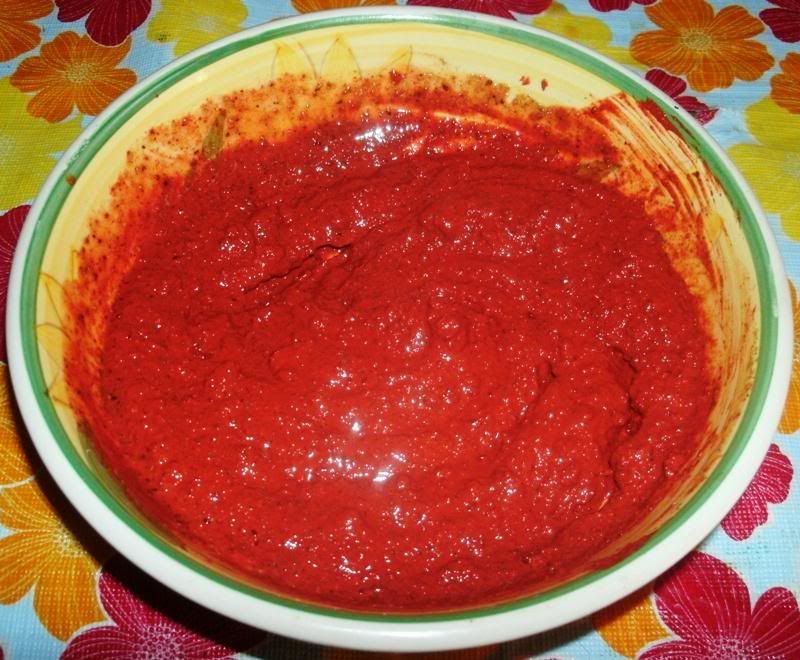
Next, I turned my attention to the ribs themselves:
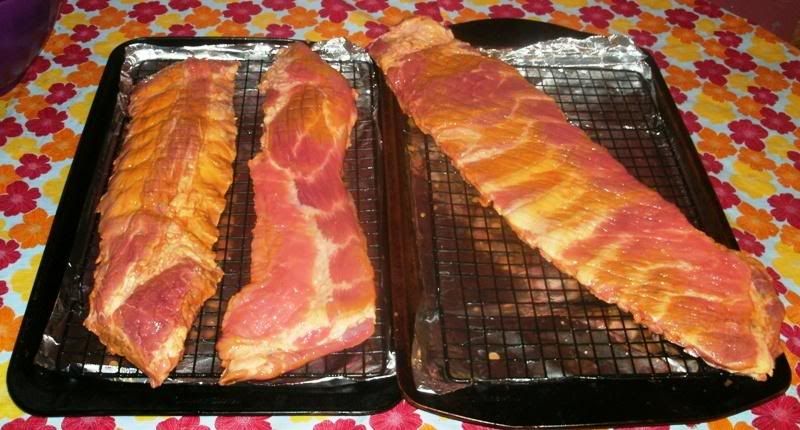
Left to right: a rack of baby backs, the trimmed brisket section and the st. louis-trimmed rack of spare ribs.
At first glance, overnight "might" be a little too long for marinating "thin" cuts like ribs in the naranja agria; 4 to 6 hours might be better, but this was also fine. Anyway, I drained and reserved the marinade, then patted the three sections dry with paper towels. Next, I slathered the achiote paste on both sides of the three sections:
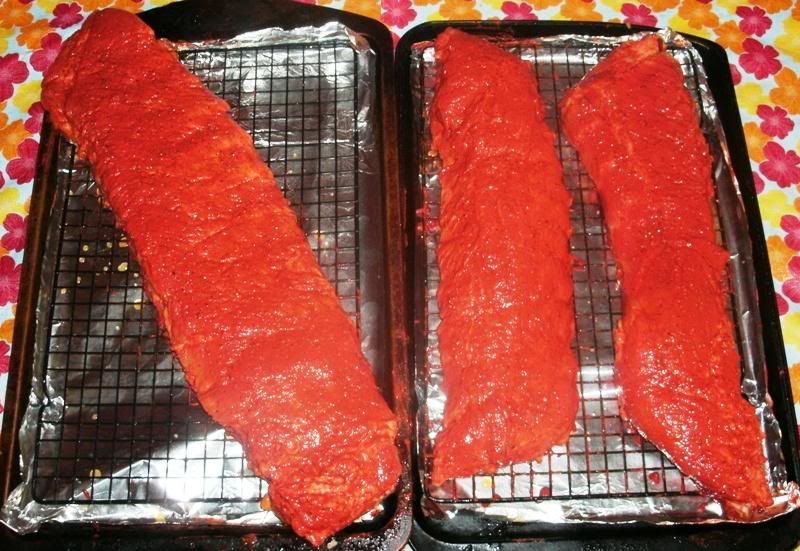
I gotta be honest, I absolutely LOVE the look of these ribs with the achiote paste:
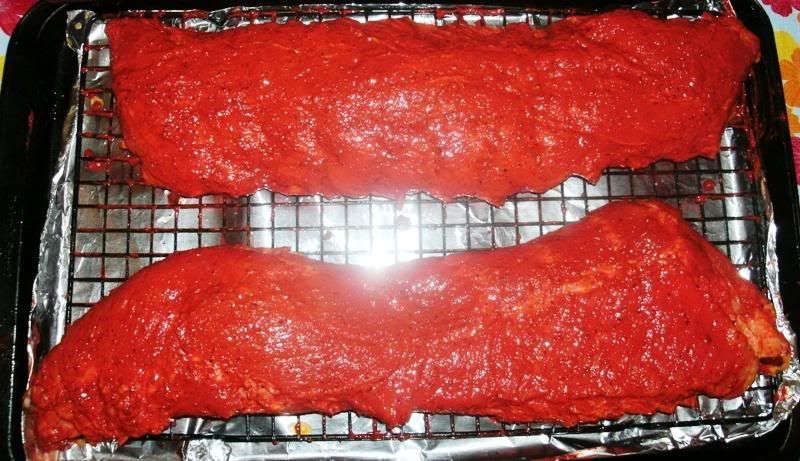

I set the ribs in the refrigerator in order to draw in the stunning Latin flavours while I heated up the pit; when the temperature was right and the hickory smoke was thin and blue, I brought them out and prepared to toss them onto the grate:

Once they were on, I threw on some old blues (supplemented by some occasional Ritchie Valens), cracked open a beer, and got down to the business of barbecue while I contemplated what to do with the rest of the reserved marinade in regards to a mop, baste or glaze. I also made a mental note to myself: when cleaning/brushing/sprucing up the pit, be sure to give the grates a final wipe-down after cleaning and seasoning in order to prevent any blackening of your beautiful ribs!
An hour into the smoke, my previously-sketchy plan began to coagulate and come into focus. I had been toying with the idea of spritzing with orange juice, plus a little oilve oil, but as it turned out, the kids drank all of the orange juice, so decided to forego the spritzing. I did, however, brush just a tiny sheen of olive oil on the ribs, in order to tide them over until they started to render their own fat and baste themselves. Here they are after about an hour and a half over the hickory:

With no mop or baste this time around, I elected to concentrate on a finishing glaze, and came up with something that I think worked pretty well.
I took the remaining naranja agria marinade, which coincidentally totaled one cup, and added a cup of dark brown sugar and a pinch or two each of allspice, nutmeg and ground cloves. After simmering it for about 10 minutes, I sampled it and found it to be really, really good. The aroma reminded me of spiced Grand Marnier, or some other orange liquer, and the taste was sweet/sour with a just hint of spice - not bad for something i made up on the spur of the moment. It was missing just some little thing, and after a moment I put my finger on it: ginger; so I added maybe half a teaspoon of that and called it good. As it turned out, this concoction did a great job of not only glazing the ribs in their final hour or two of cooking, but also complimenting the flavours of the achiote very well.
Another hour in, and the ribs were coming along nicely:

I turned them over every now and then, and added hickory or charcoal as needed to maintain a good cooking temperature, in the 240-250-degree range. When I judged they were about two or three hours away from being done, I began to "paint" the ribs with the spiced-orange glaze, going in thin layers and allowing them to "set" for a while before adding another layer. Here we are at the third or fourth layer:
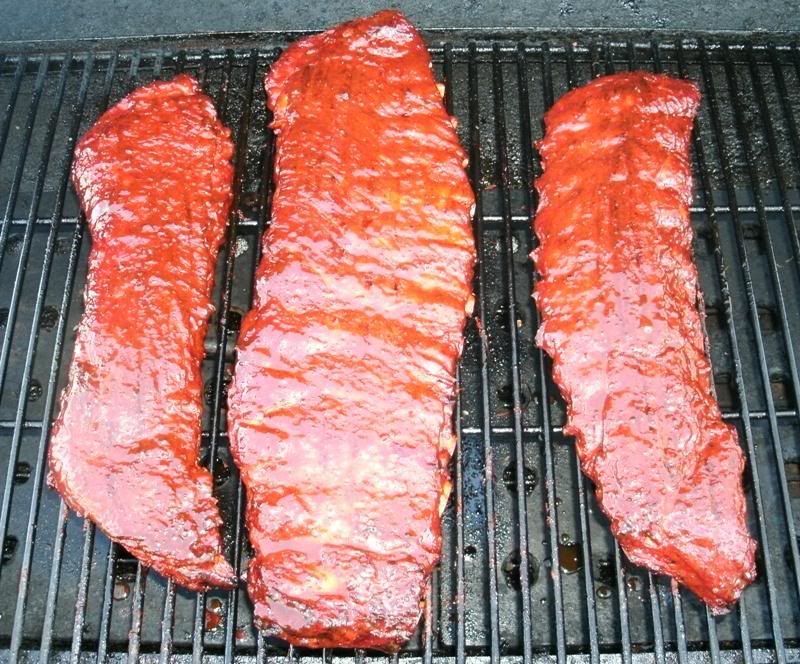
When they really were getting close to being done, I moved them a little closer to the firebox to give them some direct heat and painted on a thicker layer of the glaze:
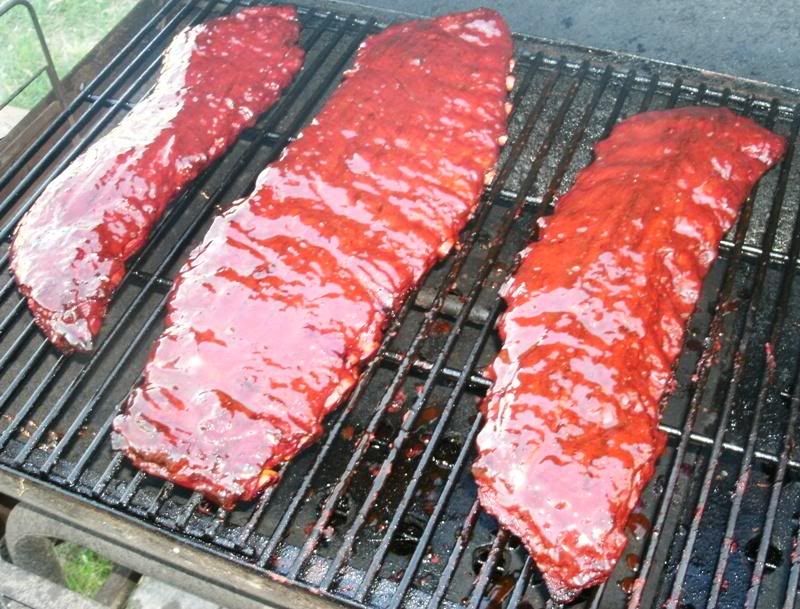
The higher heat worked its magic, and soon the glaze was bubbly-crusty carmelised onto the ribs:
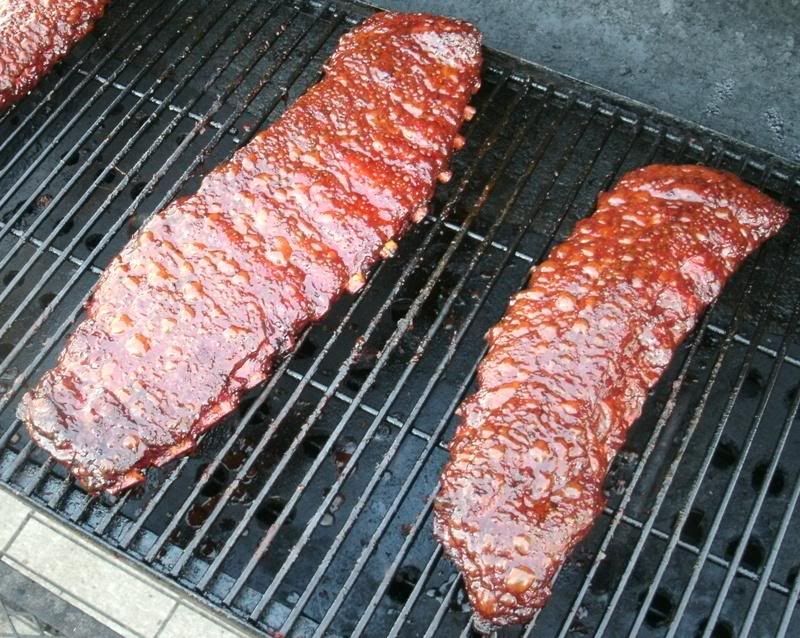
This was my cue that it was time to remove them from the heat, so I did so, and brought them into the house, where my oldest son was heating some Bush's baked beans as a side dish. Here's a rack cut from the baby backs:
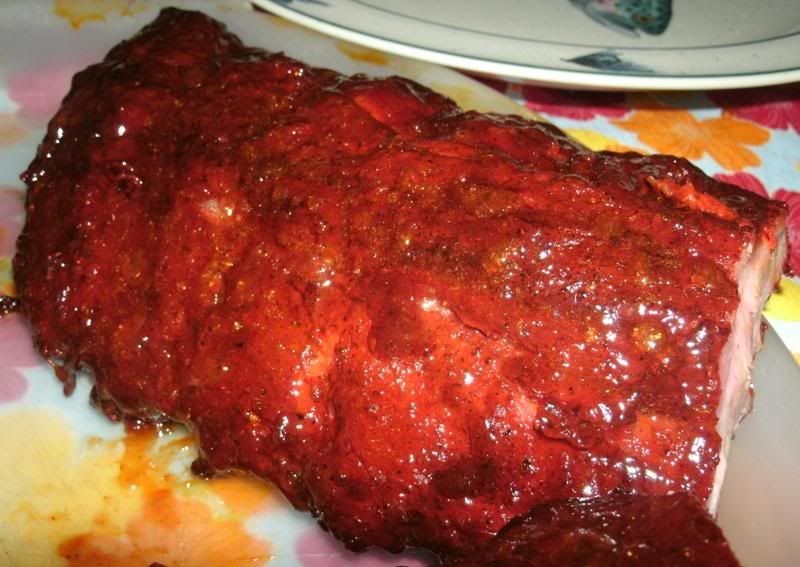
Just take a look at all the goodness going on there!
And here's a little more eye-candy, this time from the spares:
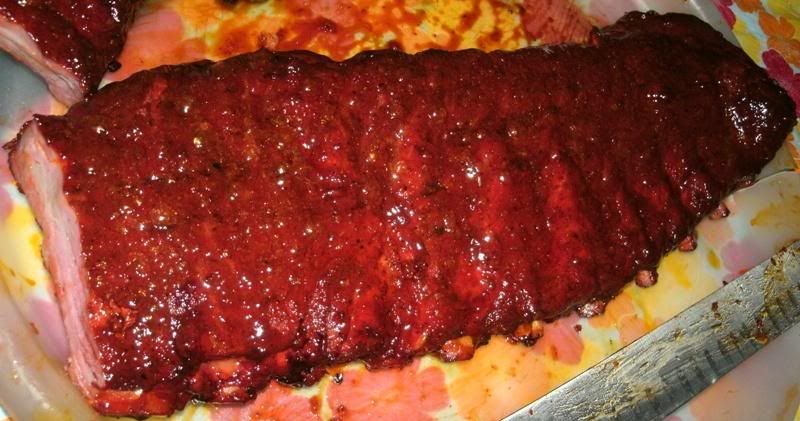
The colours here were amazing; the deep, rich red from the achiote was perfectly blended into the warm oranges and caramels brought about by the glaze. Smoke penetration was excellent, with a nice, rich smoke ring adding to the colours, and the aroma was an exotic melange of citrus, spice and smoke that added up to something far beyond the sum of its parts. This wasn't just barbecue, this was an experience to be forever cherished and repeated as often as possible.
I cut the ribs into sections along the bones and served them in simple fashion with the beans:
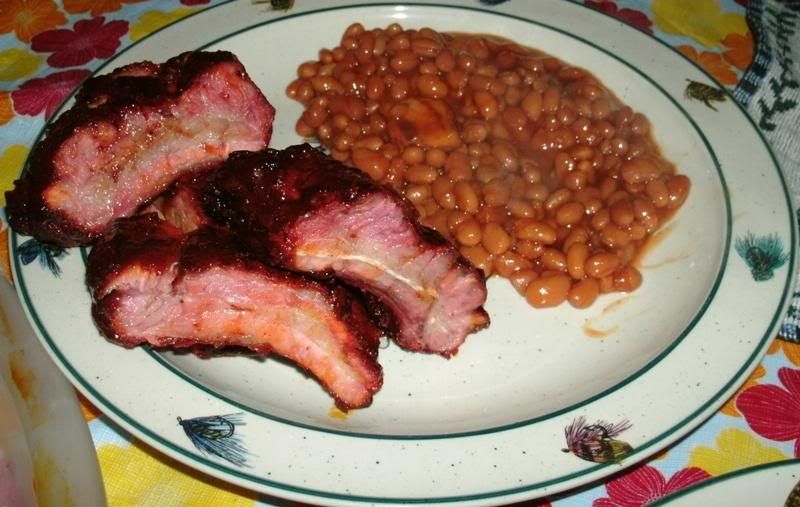
I could have embellished these with a little green from a grilled spring onion, or perhaps a sprinkling of chopped cilantro, but in truth, the family simply wanted to eat, so I fed them.
Flavours were amazing - they were everything I described above, and more. The ribs were done perfectly, with nearly all of the fat rendered out, a crispy-glazed exterior and just a hint of a tug from the bone. Everyone in the family enjoyed these ribs, and there were no leftovers.
It's pretty darn easy and only takes a small amount of effort to take a a plain ol' cut of pork and transform it into something that is absolutely wonderful. The traditions Yucatán cooking are all there, from the bright citrus highlights, down to the warm, spicy undertones, down to the deep, smoky foundation. I don't think the seasonings, spices and other ingredients (besides the ribs) cost more than 10$, and most likely just about everything is already in the pantry, or at least within easy reach for most people, so there isn't much reason not to give this a try.
We've recently been talking a lot about naranja agria, which comes from a specific orange: the Seville orange, also known as the "sour" or "bitter" orange:
foodsoftheworld.activeboards.net/forum_posts.asp?TID=2012&title=seville-naranja-agria-for-latin-cooking
Because of this, I became interested in its use in cooking, the origins of which reach all the way back to medieval Spain and the orange groves of Seville - and from there back to the cradle of civilisation via the Mohammaden conquests. Wikipedia offers some useful information:

[The]Seville orange is a widely-known, particularly tart orange which is now grown throughout the Mediterranean region. It has a thick, dimpled skin, and is prized for making marmalade, being higher in pectin than the sweet orange, and therefore giving a better set and a higher yield. It is also used in compotes and for orange-flavored liqueurs. Once a year, oranges of this variety are collected from trees in Seville and shipped to Britain to be used in marmalade....
Wiki goes on to enumerate many of the uses for the various varieties of the "bitter orange" (emphasis mine):
The unripe fruit, called narthangai, is commonly used in Southern Indian cuisine, especially in Tamil cuisine. It is pickled by cutting it into spirals and stuffing it with salt. The pickle is usually consumed with yoghurt rice thayir sadam. The fresh fruit is also used frequently in pachadis. The peel can be used in the production of bitters. The juice from the ripe fruit is also used as a marinade for meat in Nicaraguan, Cuban, Dominican and Haitian cooking. In Mexico, it is a main ingredient of the cochinita pibil.
The Belgian Witbier (white beer) is made from wheat spiced with the peel of the bitter orange. The Finnish and Swedish use bitter orange peel in gingerbread (pepparkakor), some Christmas bread and in mämmi. It is also used in the Nordic mulled wine glögg. In Greece and Cyprus, the nerántzi or kitrómilon, respectively, is one of the most prized fruits used for spoon sweets.... In Iran, the juice is used as fish marinade. The blossoms are also used to flavor tea and jam. In Turkey, juice of the ripe fruits can be used as salad dressing, especially in Çukurova region.
The Belgian Witbier (white beer) is made from wheat spiced with the peel of the bitter orange. The Finnish and Swedish use bitter orange peel in gingerbread (pepparkakor), some Christmas bread and in mämmi. It is also used in the Nordic mulled wine glögg. In Greece and Cyprus, the nerántzi or kitrómilon, respectively, is one of the most prized fruits used for spoon sweets.... In Iran, the juice is used as fish marinade. The blossoms are also used to flavor tea and jam. In Turkey, juice of the ripe fruits can be used as salad dressing, especially in Çukurova region.
My plan was to give this "sour orange" juice a try, using a quintessential Latin-American method: as a marinade for barbecued pork - in this case, spare ribs and baby back ribs.
Of course, the first step was to acquire some naranja agria, which can be quite a challenge in Montana. I was unable to locate any locally, nor could i find it in Montana's two largest "cities," Billings and Great Falls. Further inquiries to "specialty groceries" in the capital city of Helena and the university towns of Bozeman and Missoula yielded no luck. It might be somewhere in this great state, but I wasn't able to find it. One option would be to substitute a mixture of lime, orange and grapefruit juices:
Makes 3/4 cup
1/2 cup fresh orange juice
1/4 cup fresh grapefruit juice
1 tablespoon fresh lime juice
Mix all of the juices together in a jar, cover, and store in the refrigerator. The juice is best used fresh or within 2 days.
1/2 cup fresh orange juice
1/4 cup fresh grapefruit juice
1 tablespoon fresh lime juice
Mix all of the juices together in a jar, cover, and store in the refrigerator. The juice is best used fresh or within 2 days.
This would be perfectly acceptable, but I decided to make use of the internet and order some from Amazon:
www.amazon.com/Badia-Sour-Orange-Naranja-Agria/dp/B000AQFF8G/ref=sr_1_3?s=grocery&ie=UTF8&qid=1334083758&sr=1-3

The product description states that it is made from Seville oranges, so it is the real deal ~ perfect for what I was looking for. When it arrived last week, I was ready to get this going, so Friday, I bought a rack of baby back ribs and a rack of spare ribs, the latter of which I trimmed St. Louis style:
foodsoftheworld.activeboards.net/forum_posts.asp?TID=1327&title=trimming-spareribs-st-louis-style
I marinated the ribs overnight in a bottle of the naranja agria, to which i added a small amount of salt, cumin, granulated garlic, coriander and annato (about two teaspoons altogether).
Saturday morning, I commenced with this project - the first real barbecue of the year. I began by sprucing up my modified SnP (here's an old thread describing mods in detail and in sequence):
foodsoftheworld.activeboards.net/forum_posts.asp?TID=203&title=modifications-for-the-brinkmann-smoken-pit
The winter and the passage of time had added a little rust here and there, especially over the firebox, but no worries at all ~ when the pit heated up, I gave it a good wire brushing and then a rub-down with some lard, in 3 or 4 layers, which seasoned it beautifully, just like a cast-iron pan. This took care of the rust and brought it back to better-than-new condition.
With the pit ready for its first firing-up of the year, I turned my attention to preparing my ribs. Aside from the overnight bath in the naranja agria marinade, here's a shot of everything I used:

As you can see, we're not looking at anything complicated here, but the resulting flavours are full of depth and character, heightened by the citrus blast from the Seville orange juice.
The medium for this masterpiece from the Yucatán was a paste made from achiote roja, a block of wonderful Latin flavours that can be found just about anywhere except where I live:

I had to go 250 miles to Billings in order to get this stuff; considering the simple-yet-wonderful ingredients, I might experiment in the future with making this on my own from scratch.
One thing I wanted to do was to give a real boost to the flavours found in the achiote, so I added a few spices:

Clockwise from top: a teaspoon each (scant or generous, depending on the ingredient) of salt, ground cloves, allspice, coriander and pepper; I would also have added the same amount of granulated garlic, but for some reason, none could be found in the house.
After measuring out the spices, I opened the block of achiote roja and added 2 tablespoons of the reserved naranja agria marinade:

I then added the spices and i stirred it all together to make a beautiful-looking, deep-crimson paste:

Next, I turned my attention to the ribs themselves:

Left to right: a rack of baby backs, the trimmed brisket section and the st. louis-trimmed rack of spare ribs.
At first glance, overnight "might" be a little too long for marinating "thin" cuts like ribs in the naranja agria; 4 to 6 hours might be better, but this was also fine. Anyway, I drained and reserved the marinade, then patted the three sections dry with paper towels. Next, I slathered the achiote paste on both sides of the three sections:

I gotta be honest, I absolutely LOVE the look of these ribs with the achiote paste:


I set the ribs in the refrigerator in order to draw in the stunning Latin flavours while I heated up the pit; when the temperature was right and the hickory smoke was thin and blue, I brought them out and prepared to toss them onto the grate:

Once they were on, I threw on some old blues (supplemented by some occasional Ritchie Valens), cracked open a beer, and got down to the business of barbecue while I contemplated what to do with the rest of the reserved marinade in regards to a mop, baste or glaze. I also made a mental note to myself: when cleaning/brushing/sprucing up the pit, be sure to give the grates a final wipe-down after cleaning and seasoning in order to prevent any blackening of your beautiful ribs!
An hour into the smoke, my previously-sketchy plan began to coagulate and come into focus. I had been toying with the idea of spritzing with orange juice, plus a little oilve oil, but as it turned out, the kids drank all of the orange juice, so decided to forego the spritzing. I did, however, brush just a tiny sheen of olive oil on the ribs, in order to tide them over until they started to render their own fat and baste themselves. Here they are after about an hour and a half over the hickory:

With no mop or baste this time around, I elected to concentrate on a finishing glaze, and came up with something that I think worked pretty well.
I took the remaining naranja agria marinade, which coincidentally totaled one cup, and added a cup of dark brown sugar and a pinch or two each of allspice, nutmeg and ground cloves. After simmering it for about 10 minutes, I sampled it and found it to be really, really good. The aroma reminded me of spiced Grand Marnier, or some other orange liquer, and the taste was sweet/sour with a just hint of spice - not bad for something i made up on the spur of the moment. It was missing just some little thing, and after a moment I put my finger on it: ginger; so I added maybe half a teaspoon of that and called it good. As it turned out, this concoction did a great job of not only glazing the ribs in their final hour or two of cooking, but also complimenting the flavours of the achiote very well.
Another hour in, and the ribs were coming along nicely:

I turned them over every now and then, and added hickory or charcoal as needed to maintain a good cooking temperature, in the 240-250-degree range. When I judged they were about two or three hours away from being done, I began to "paint" the ribs with the spiced-orange glaze, going in thin layers and allowing them to "set" for a while before adding another layer. Here we are at the third or fourth layer:

When they really were getting close to being done, I moved them a little closer to the firebox to give them some direct heat and painted on a thicker layer of the glaze:

The higher heat worked its magic, and soon the glaze was bubbly-crusty carmelised onto the ribs:

This was my cue that it was time to remove them from the heat, so I did so, and brought them into the house, where my oldest son was heating some Bush's baked beans as a side dish. Here's a rack cut from the baby backs:

Just take a look at all the goodness going on there!
And here's a little more eye-candy, this time from the spares:

The colours here were amazing; the deep, rich red from the achiote was perfectly blended into the warm oranges and caramels brought about by the glaze. Smoke penetration was excellent, with a nice, rich smoke ring adding to the colours, and the aroma was an exotic melange of citrus, spice and smoke that added up to something far beyond the sum of its parts. This wasn't just barbecue, this was an experience to be forever cherished and repeated as often as possible.
I cut the ribs into sections along the bones and served them in simple fashion with the beans:

I could have embellished these with a little green from a grilled spring onion, or perhaps a sprinkling of chopped cilantro, but in truth, the family simply wanted to eat, so I fed them.
Flavours were amazing - they were everything I described above, and more. The ribs were done perfectly, with nearly all of the fat rendered out, a crispy-glazed exterior and just a hint of a tug from the bone. Everyone in the family enjoyed these ribs, and there were no leftovers.
It's pretty darn easy and only takes a small amount of effort to take a a plain ol' cut of pork and transform it into something that is absolutely wonderful. The traditions Yucatán cooking are all there, from the bright citrus highlights, down to the warm, spicy undertones, down to the deep, smoky foundation. I don't think the seasonings, spices and other ingredients (besides the ribs) cost more than 10$, and most likely just about everything is already in the pantry, or at least within easy reach for most people, so there isn't much reason not to give this a try.






